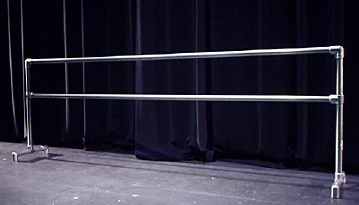|
Introduction:
Ballet (or Dance) Barres (or Bars) are
railings that dancers use to help practice positions and movements that are balance sensitive. The barre gives the dancer
a steady object to hold on to during rehearsal. The barres may also be used by the dancer as an aid in stretching during warm
up.
Note: The following information is mostly subjective in content. However, when I can, I do cite sources which
are listed at the end of the document. If you have any comments please e-mail them at: Comments@halebarre.com
Contents
Types of Barres:
There are generally two types of barres: Fixed or Portable.
Fixed
Barres are generally wall mounted (though any barre permanently mounted so it cannot move qualifies as a Fixed Barre).
They consist of a horizontal round rail that has been attached to a wall or floor in some way.
Portable Barres
(also known as Free-standing) are designed to be moved around. They usually consist of a horizontal round rail mounted between
two uprights that have legs and feet on the bottom of them. They are moved into position during that portion of a class or
rehearsal when needed, and then are stored away elsewhere when the dance space has to be clear.
For dancers beyond the
beginner level a portable barre also prevents the dancer from forcing or "cheating" when practicing turnouts as can be done
on fixed barres. Streaching on a portable barre helps with developing balance and core strengh. Thus, I believe that a portable
barre should not be so heavy or have such a wide base that it cannot tip when excessive horizontal force is applied.
While
most portable barres consist of a single line of rail(s), there are triangular and square shaped barres that have been made.
These barres can take up a large amount of room in storage unless they have been designed to fold flat. They also can be so
stable that the benefits of a "tippy" barre is lost.
Both Fixed and Portable barres are referred to as a Single
Barre if the assembly consists of a single rail. Two rails in the same assembly are referred to as a Double Barre. For dance
studios double barres have the advantage of accommodating a wide age range of students. Double barres are also inherently
stronger in construction.
Size:
There is no standard size for a barre. Depending on how and with what it
is made the rail diameter can vary from 1 to 2 inches. 1 1/2 to 2 inches is generally considered the most comfortable. Height
also varies, though some point at, or just above, the waist (40+ inches for most adults) is usually preferred. The shortest
length of a portable barre is usually about 4 feet, with anything over 12 feet generally being too awkward (and heavy) to
easily move or store.
Barres can be made from Wood, Metal and Plastic.
Here are my opinions on the three
materials-
Wood
The classic material for the barre. It is relatively light in weight and pleasing in appearence
and touch. Getting long lenghts (6 feet +) of good quality wood railing can be a challenge and expensive. Cheaper wood railing
will more easly splinter and/or split over time. It is weaker than most metals used for barre construction but stronger than
PVC plastic.
For fixed barres it is a reasonable choice as wall or floor supports can be spaced as close as needed. For
portable barres it is a more problimatic material as there is more of a tendency for the wood to work loose from its supports
when the barre is moved around.
Metal
My favorite overall. Relatively strong and inexpensive (depending on
the metal used). With steel weight can be an issue if Schedule 40 pipe is used. EMT/EMC steel tubing, on the other hand, has
a reasonable strength to weight ratio for a barre but needs to be welded or used with special fittings (available from Hale
Barre Systems).
Aluminum has the advantage of being light in weight but but is weaker than steel and may need more support.
It also must be powder coated or annodized as raw aluminum will turn your hands black when handled for any length of time.
It is generally more expensive than steel.
When used for fixed barres metal may or may not be less expensive than wood
depending on the cost of the pipe or tubing and the fittings used. Weight is generally not an issue so Schedule 40 steel pipe
and fittings may be cost effective.
Portable barres made of metal are generaly long lasting as long as basic maintenance
(i.e. tightening loose fittings) is taken care of.
Plastic
I am refering to PVC pipe here. It has the great
advantage of being very inexpensive and light. PVC pipe and fittings are also probably the most available material at the
local level.
For fixed barres I do not recommend using PVC pipe as the fittings available are not stong enough for this
application.
For portable barres PVC pipe is an option, especially when a studio is just starting up, cash is tight, and
most of the students are young. The main drawback to portable PVC barres is that they do have a limited life. As the barres
are moved about and subjected to the heavier weight of older students they will start to break down and come apart. When using
PVC barres in a dance school situation I would plan on no more than a 5 to 7 year useful life, though I have seen some 10
year old PVC barres at one studio. However, these were used by the younger students, never used to streach on, and always
carried, never dragged, when being setup or put away.
|

